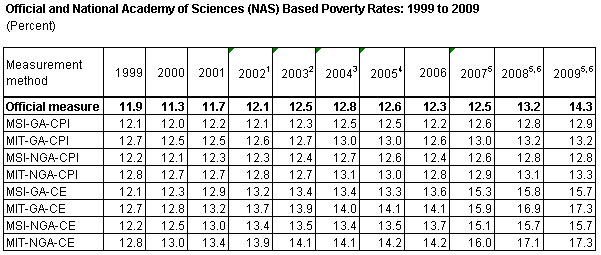The Census Bureau released its latest report on poverty today, and it unsurprisingly tells us that incomes are down and poverty is up. However, there’s much gnashing of teeth in the blogosphere over the fact that Census figures account only for cash income, not for various government transfers and benefits. See Tim Worstall here, for example.
So how much poverty is there after you account for food stamps and Section 8 housing and Medicaid benefits? Good question! And the Census Bureau is going to tell you. But not until next month:
Alternative/Experimental Poverty Measures
Families and individuals also derive economic well-being from noncash benefits, such as food and housing subsidies, and their disposable income is determined by both taxes paid and tax credits received. The official poverty thresholds developed more than 40 years ago do not take into account rising standards of living or such issues as child care expenses, other work related expenses, variations in medical costs across population groups, or geographic differences in the cost of living. Poverty estimates using the new Supplemental Poverty Measure, for which the Census Bureau expects to publish preliminary estimates in October 2011, will address many of these concerns.
It’s worth noting that the new measure includes things that reduce poverty (mostly government welfare programs) and things that increase it (high medical inflation and rising child care expenses). So it’s not clear how much the measured poverty rate will change on net. I guess we’ll know next month. As a sneak peek, though, here’s a table showing the official poverty rate compared to a variety of alternative measures from last year’s report. (The alternatives come from the National Academy of Sciences, on which the new measure will be based.) Generally speaking, the differences aren’t huge, and they all show poverty increasing, at least over the past decade. So I wouldn’t expect any gigantic surprises when the official report that accounts for everything finally comes out next month.


















